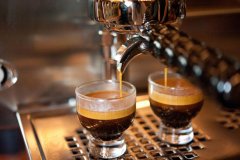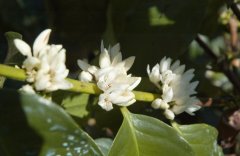The basics of fine coffee do you know what caffeine is?

What is caffeine? Caffeine is a substance found in the leaves, roots and fruits of 100 plants in nature. it is also a mixture of methylxanthine. Caffeine usually comes from coffee, dimethoate and tea. Caffeine is also used in "energy drinks" and drugs to treat colds and flu. Coffee and tea also contain theophylline, another dimethylxanthine. Theophylline has properties similar to caffeine and theobromine, but its pharmacological effects are far inferior to caffeine and theobromine. The amount of caffeine in the product is determined by the product type, the total amount of the product and the preparation method. For example, 190ml tea contains 50mg caffeine, which is lower than 75mg of the same amount of coffee. The following table lists the amount of caffeine in other drinks. We consume an average of 3.98 milligrams per kilogram of body weight per day, for example, a person of 60 kilograms consumes 239 milligrams of caffeine per day. What is monsoon coffee? Monsoon coffee (rainy season Malaba) is a unique coffee from southern India using a typical air-drying process, specially stored in an open warehouse and exposed to the monsoon to increase viscosity and reduce acidity. Monsoon coffee is stored in a special warehouse until the monsoon arrives, and the ventilation structure is designed to allow the moist monsoon to circulate between the coffee beans, so that its volume expands and shows a mellow but strong mildew smell. The monsoon process is labor-intensive: coffee is spread out in special ventilated warehouses and raked or turned by hand to allow coffee beans to absorb moisture in the moist wind. The whole process takes 12 to 16 months, in which the coffee beans expand to twice their original volume and have a dull golden yellow. Then the coffee beans that are not fully inflated are picked out with extra processing, and the rest of the coffee is to be exported. The aroma of this dried coffee is not very strong, but with the addition of water, a combination of strongly roasted nuts (dry-roasted peanuts), caramel and tobacco come to the nostrils. What is shadow coffee (or bird-friendly coffee)? Shaded coffee is coffee that grows in the shade of the awning (shade is formed by local mixed trees). Traditional Arabica coffee grows in shady places in Mexico, Central America, Colombia, Peru and Venezuela and other countries of the world, including India and Indonesia, as well as many parts of Africa. Other Arabica coffee grows in sunny or near-sunny areas. Because these shady awnings also provide habitat for migrating birds in Central America, coffee grown under local awnings is also known as "bird-friendly coffee". Most of the shadow coffee is significantly easier to adapt to the environment than the coffee grown in the sun, and the best Central American coffee grows mostly in the shade. What is bourbon coffee? A plant variety of Arabica coffee, bourbon coffee first appeared in Bobang Island, now Reunion Island. These delightful coffees are exported from the island of Bobang to Latin America and Africa. Some of the best Latin American coffees come from bourbon trees, which are best grown at 1000-2000 meters above sea level. What are pea-shaped coffee beans? Pea-shaped coffee beans (also known as Caracol) are small, round, bean-shaped fruits, usually shaped in two halves, but this bean is a whole, growing in the center of the coffee fruit. Pea coffee beans are usually separated from ordinary beans and sold as distinct coffee beans. They are popular in the Japanese market at high prices. They come from the same plants as ordinary coffee beans, but select coffee beans that are brighter, more acidic and refreshing and fragrant. What is wet coffee? This kind of coffee is peeled and separated from the pulp when the beans are still wet. Most of the world's most famous coffee is wet-processed to strengthen its acidity. In traditional wet processing, the coffee skins are separated and the peeled coffee beans are placed in a container so that the enzyme loosens the sticky peel or mucus (fermentation), and the loose fruit is then washed off (washed). A more modern method is to use a machine to remove the pulp or mucus. In this way, there is still a layer around the processed coffee beans. when dried, this layer is called parchment, and the parchment outlet of the coffee beans is traded as coffee with a skin, and this layer is peeled before grinding and baking. What are hard beans and soft beans coffee? Hard bean coffee is coffee that grows at a relatively high altitude, while coffee grown at a lower altitude is generally considered soft bean coffee. Higher altitude and lower temperature make the fruit ripen more slowly, and form harder and less porous coffee beans. Hard bean coffee usually has higher acidity and more flavor, although sometimes there are some exceptions. The distinction between hard beans and soft beans is often used to assess the grade of coffee in Central America. What is chicory coffee (coffee substitute)? Chicory, an evergreen plant from Europe, was brought to North America in 1700. Fresh young leaves can be used for raw food in salads, while old leaves are bitter and can be boiled in water and eaten. But it is famous for its close relationship with coffee, which was once difficult to obtain or expensive in history. In these days, people usually roasted chicory as a substitute for coffee. The root of chicory is long and thick, like the main root of dandelion, and when dried and roasted, it becomes an excellent substitute for coffee. There is no caffeine in chicory, which produces more roasting flavor than coffee, and many coffee producers use up to 30% of chicory to mix coffee with less caffeine. People also use roasted acorns, yams and other local grains to make coffee.
Important Notice :
前街咖啡 FrontStreet Coffee has moved to new addredd:
FrontStreet Coffee Address: 315,Donghua East Road,GuangZhou
Tel:020 38364473
- Prev

Yerga Coffee is actually a small town.
Yegasherfi is a small town with an altitude of 1700- 2100 meters. It is also synonymous with Ethiopian fine beans. This is a wetland since ancient times. The old saying "yirga" means "settle down","cheffe" means "wetland", so "yirga cheffe" means "let us settle down in this wetland". It is one of Ethiopia's highest coffee producing areas on average. Yegassie
- Next

Where does the real caffeine aroma of black coffee come from?
In a coffee obsession like mine, there is no smell comparable to the smell in the coffee field during the flowering period. The first flowering period of the coffee tree is about three years. The white flowers are five-petal tube-shaped flowers, with a faint fragrance of jasmine, and the inflorescences are arranged in dense clusters. It will wither after two or three days of flowering and begin to bear fruit after a few months. In Yunnan, this is the right time.
Related
- Detailed explanation of Jadeite planting Land in Panamanian Jadeite Manor introduction to the grading system of Jadeite competitive bidding, Red bid, Green bid and Rose Summer
- Story of Coffee planting in Brenka region of Costa Rica Stonehenge Manor anaerobic heavy honey treatment of flavor mouth
- What's on the barrel of Blue Mountain Coffee beans?
- Can American coffee also pull flowers? How to use hot American style to pull out a good-looking pattern?
- Can you make a cold extract with coffee beans? What is the right proportion for cold-extracted coffee formula?
- Indonesian PWN Gold Mandrine Coffee Origin Features Flavor How to Chong? Mandolin coffee is American.
- A brief introduction to the flavor characteristics of Brazilian yellow bourbon coffee beans
- What is the effect of different water quality on the flavor of cold-extracted coffee? What kind of water is best for brewing coffee?
- Why do you think of Rose Summer whenever you mention Panamanian coffee?
- Introduction to the characteristics of authentic blue mountain coffee bean producing areas? What is the CIB Coffee Authority in Jamaica?

